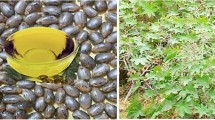Abstract
Biodiesel has become an interesting alternative to be used in diesel engine, because it has similar properties to the traditional fossil diesel fuel and may, thus, substitute conventional fuel with none or very minor engine modification. This article deals with alkaline transesterfication of castor oil and their properties for engine application. The purpose of the transesterfication process is to lower the viscosity of the oil from 226.82 cS to 8.50 cS ‘at’ 38°C. The flash point values of castor methyl esters are lower than that of castor oil. The density and gross calorific value of castor methyl ester are much closer to those of diesel. If 10% of total production of castor seed oil is transesterfied into biodiesel, then about 79,782 tones of CO2 emission can be saved on annual basis. The CO2 released during combustion of biodiesel can be recycled through next crop production, therefore, no additional burden on environment.


Similar content being viewed by others
References
Castor outlook (2005) Karvys special reports 20051119-01. www.karvycomtrade.com. Accessed 20 Mar 2009
Castor seed Seasonal Report (2008) Karvys special reports 20080424-02. www.karvycomtrade.com Accessed 20 Mar 2009
Clark WC, Munn RE (1987) Sustainable development of biosphere. Cambridge University press, Cambridge
Conceicao MM, Roberlucia A, Candeia RA, Hermesson J, Dantas HJ, Soledade LEB, Fernandes VJ, Souza AG (2005) Rheological behavior of castor oil biodiesel. Energy Fuels 19(5):2185–2188
Conceicao MM, Candeia RA, Silva FC, Bezerra AF, Fernandes VJ Jr, Souza AG (2007) Thermoanalytical characterization of castor oil biodiesel. Renew Sustain Energy Rev 11(5):964–975
Da Silva NDLD, Maciel MRW, Batistella CB, Filho RM (2006) Optimization of biodiesel production from castor oil. Appl Biochem Biotechnol 130(1–3):405–414
Demirbas A (2009) Progress and recent trends in biodiesel fuels. Energy Convers Manage 50(1):14–34
Emission calculator. http://www.scionresearch.com/BKC/CO2_emission_calculator.html Accessed 20 Mar 2009
Krawczyk T (1996) Biodiesel—alternative fuel makes inroads but hurdles remain. INFORM 7:801–829
Meneghetti SMP, Meneghetti MR, Wolf CR, Silva EC, Lima GES, Silva LD, Serra TM, Cauduro F, Oliveira LG (2006) Biodiesel from castor oil: a comparison of ethanolysis versus methanolysis. Energy Fuels 20:2262–2265
Naik M, Meher LC, Naik SN, Das LM (2008) Production of biodiesel from high free acid Karanja (Pongamia pinnata) oil. Biomass Bioenergy 32(5):354–357
Panwar NL, Shrirame HY (2009) The emission characteristics of a compression ignition engine operating on castor oil methyl ester. Int J Global Warm 1(1–3):368–377
Panwar NL, Shrirame HY, Rathore NS, Jindal S, Kurchania AK (2010) Performance evaluation of a diesel engine fueled with methyl ester of castor seed oil. Appl Therm Eng 30:245–249
Powlson DS, Riche AB, Shield I (2005) Biofuels and other approaches for decreasing fossil fuel emissions from agriculture. Annals Appl Biol 146(2):193–201
Rathore NS, Panwar NL, Kurchania AK (2008) Jatropha: cultivation and processing practices. Himanshu Publication, Udaipur (India)
Refaat AA, Attia NK, Sibak HA, El Sheltawy ST, ElDiwani GI (2008) Production optimization and quality assessment of biodiesel from waste vegetable oil. Int J Environ Sci Technol 5(1):75–82
Scholz V, Da Silva JN (2008) Prospects and risks of the use of castor oil as a fuel. Biomass Bioenergy 32(2):95–100
Sensoz S, Angin D, Yorgun S (2000) Influence of particle size on the pyrolysis of rapeseed (Brassica napus L.): fuel properties of bio-oil. Biomass Bioenergy 19:271–279
Sheehan J, Cambreco V, Duffield J, Garboski M, Shapouri H (1998) An overview of biodiesel and petroleum diesel life cycles. A report by US department of agriculture and energy, pp 1–35
Sims REH (2003) Bioenergy to mitigate for climate change and meet the needs of society, the economy and the environment. Mitig Adapt Strategies Global Changes 8(4):349–370
Tavita YL, Manas AE (1989) Development of oil finish from castor plant (Ricinus communis L.) seeds. FPRDI J Philipp 18(1–4):15–29
Turner C, Whitehand Lc, Nguyen T, Mckeon T (2004) Optimization of a supercritical fluid extraction/reaction methodology for the analysis of castor oil using experimental design. J Agric Food Chem 52(1):26–32
Utamura M (2005) Analytical model of carbon dioxide emission with energy payback effect. Energy 30(11–12):2073–2088
Xue F, Zhang Xu, Luo H, Tan T (2006) A new method for preparing raw material for biodiesel production. Process Biochem 41(7):1699–1702
Author information
Authors and Affiliations
Corresponding author
Rights and permissions
About this article
Cite this article
Panwar, N.L., Shrirame, H.Y. & Bamniya, B.R. CO2 mitigation potential from biodiesel of castor seed oil in Indian context. Clean Techn Environ Policy 12, 579–582 (2010). https://doi.org/10.1007/s10098-009-0269-5
Received:
Accepted:
Published:
Issue Date:
DOI: https://doi.org/10.1007/s10098-009-0269-5




